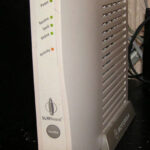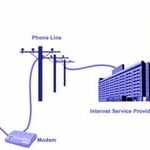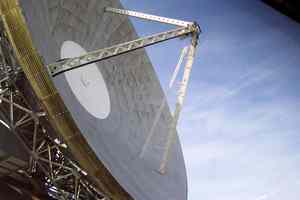Although television and radio advertisements generally tout one type of internet service as better than the others, DSL, satellite, cable, and dial-up internet access all offer some benefits as well as disadvantages.
DSL (Digital Subscriber Line): This type of internet access enables websites and files to load very quickly, and it tends to be less expensive than cable internet service. It may or may not be cheaper than dial-up access, depending upon the internet service providers available in your area. DSL is not available in some rural areas. It connects to your computer through an external modem which is plugged into a telephone jack and attaches to the computer with a USB or Ethernet cable. Although DSL comes through your telephone line, you don’t have to dial into it, and it doesn’t prevent you from using the telephone or receiving calls – one of its best advantages in comparison to dial-up internet service. According to Wikipedia.org, a fax machine or regular dial-up modem can be used at the same time as a DSL modem, on the same phone line. This makes it possible to connect two computers to the internet at the same time with one phone line, if one uses dial-up and the other DSL. If you have an older computer, the system requirements for DSL may make it necessary to upgrade or replace it. For example, Verizon DSL requires Windows 98 or later, a 266MHz or faster CPU, and at least 64MB of memory. DSL can also be used on some Apple Macintosh computers; other system requirements apply. A different type of DSL, called “naked DSL”, is also available but less common; it allows users to access DSL service without having a regular telephone subscription. This might be attractive to those who only use a cell phone or, as an article on CNet.com suggests, want to use Voice-Over-Internet-Protocol instead of a telephone.
DIAL-UP: Although it is slower than DSL or cable, dial-up is more widely available, and has minimal system requirements. It is also less susceptible to some viruses. Unlike DSL and cable, dial-up access is available almost anywhere, including most rural areas. It generally costs about $11-$25/month, depending upon the service provider. For the most part, it is possible to access the internet through dial-up on any computer with a modem and the appropriate software. However, you probably wouldn’t want to do this on any computer with a processor/CPU slower than 75MHz, unless you are very patient or only use it for e-mail and entirely text-based websites. A disadvantage of dial-up access is that it prevents the telephone line from being used for regular voice communication while connected, unlike DSL (which also uses telephone lines but filters out the data noise). If you use dial-up, you may want to determine if your telephone company offers an answering service (usually inexpensive) which will allow callers to leave you a message when your phone line is busy or you don’t answer (this also eliminates the need for an answering machine). Dial-up access tends to be faster in urban areas; it usually ranges from about 22kbps to 53kbps, and may vary slightly from time to time. A high dial-up connection speed (48-53kbps) and a fairly fast computer (over 300MHz) can make loading most websites acceptably fast and even allow for somewhat-choppy streaming video, although large downloads will still be lengthy. Streaming audio (such as listening to radio online) usually works acceptably on dial-up connections. Although hour limits were more common in the past, most dial-up subscriptions now provide unlimited access. Some internet service providers still offer cheaper hour-based plans, such as twenty hours/month for $9.95, which may be preferable if you only use the internet occasionally. You might also be able to receive a discount by paying for several months or a year of service in advance.
DIAL-UP BOOSTER: Some dial-up services offer a “booster” or “accelerator” service for about $4-6 extra per month, which speeds up some types of internet activity. One service provider, GWI.Net, indicates on their website that their dial-up booster service ($3.95 extra/month) increases the speed of most graphics, webpages, text, and e-mail, but not secure websites or streaming audio/video. Somewhat higher system requirements usually apply when these services are used. Both GWI.Net and RCN.com indicate that their booster/accelerator services require a 200MHz or faster processor, Windows 95b or later, and 64MB or more of RAM/memory. However, the majority of computers being used today meet these requirements. Somewhat higher system requirements apply to Apple Macintosh computers.
CABLE: This type of internet access tends to be more expensive than dial-up or DSL. Some cable providers offer a discount if cable television and/or other services are also subscribed to. Radio and television ads for cable-based internet often promote it as being faster than both DSL and dial-up. According to an article on Webopedia.com, DSL and cable speeds are affected by different factors, so it isn’t entirely clear which type of service is actually faster. An article on About.com states that “while cable Internet will theoretically run faster than DSL, several technical and business reasons can reduce or even eliminate this advantage.” Regardless of any actual speed difference, most internet users aren’t likely to notice a great difference between different high-speed connections, unless perhaps if they frequently conduct very large file downloads. The availability of cable internet access in rural areas is generally more widespread than DSL but less than dial-up or satellite. System requirements for cable, like DSL, are fairly high. For example, Time Warner cable’s Road Runner service requires Windows 2000 or XP, a 450MHz or faster CPU, and 128MB or more memory, which substantially exceeds the requirements for Verizon DSL and far exceeds those for dial-up internet access.
SATELLITE: Internet access through a satellite dish is generally more costly and requires a more complex installation than other options, but provides a method of high-speed connection with greater availability than cable or DSL. Like satellite television, it is available anywhere that a satellite dish can be pointed at the sky without obstructions; this may be problematic in areas with many tall trees or buildings. HughesNet, formerly DirecWay, offers multiple service plans (Home, Pro, ProPlus) with different levels of download and upload speed. Download speeds are at least 500kbps and as high as 1.5mbps, depending upon the plan. As of 03/09/07, the cheapest plan costs $59.99/month, not including the cost of equipment, installation, and any additional internet-related services. Satellite internet access is also available through EarthLink, although it is “powered by” HughesNet. System requirements indicated on the HughesNet website are relatively low; it requires a minimum of Windows 98 Second Edition or Mac OS 10.1 and “10/100 Ethernet pre-equipped” network capability.
Overall, the best type of internet access for you depends upon what options are available in your area, the specifications of your computer, how you use the internet (and how often), and how much you are willing to spend.






